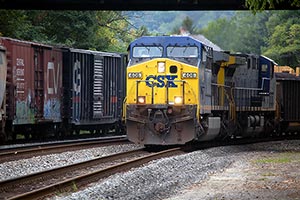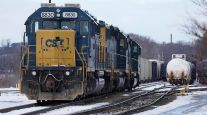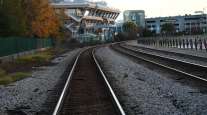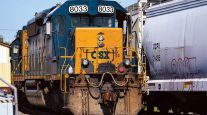Maryland Seeks $155 Million From Feds to Clear Freight Rail Bottleneck Beneath Baltimore

The state and the railroad CSX Transportation have agreed to a plan to remove a bottleneck for freight shipping beneath the streets of Baltimore and have requested $155 million in federal funding to help pay for the project they say will boost Maryland's economy.
State and railroad officials have pledged to contribute $270 million toward expanding the 1.7-mile Howard Street Tunnel. The additional clearance would allow shipping containers from the Port of Baltimore, for the first time, to be stacked two-high atop trains, a far more efficient way to move them.
"This is going to be transformative," said Louis Renjel, vice president for strategic infrastructure at Jacksonville, Fla.-based CSX. "If you think about the Port of Baltimore ... it's got deep water and on-dock rail service. The last piece of the puzzle to be the most competitive that you can be is that double-stack rail. When Baltimore has those three pieces, they're really going to be positioned well for the future."
The port fell behind other East Coast ports in recent decades in part due to the difficulty of shipping containers out of the port's terminals by rail.
The Howard Street Tunnel, built in the 1890s by the Baltimore and Ohio Railroad, a predecessor of CSX, has been the culprit. Officials have grappled with how to expand the tunnel beneath the heart of the city for years.
About 1.5 feet more of clearance is needed to fit the stacked containers and expand the tunnel, about 19.5 to 21 feet. The work was previously estimated to cost between $1 billion and $3 billion and require Howard Street to be shut down during construction.
"That, obviously, would be immensely disruptive to the city and arguably infeasible," Renjel said.
As an alternative, the state sought a site for a CSX rail terminal south of Baltimore where trucks could bring containers from the port to be loaded on double-stack trains. But the state pulled the plug on funding in 2014 for a potential terminal in Morrell Park amid intense opposition from the community.
The decision left state transportation and railroad officials scrambling for an alternative and planners turned their attention back to the tunnel.
Recent advances in engineering now make it possible to increase the tunnel's clearances with much of the construction underground and for much less money, Renjel said.
"We're underground the whole time — that was a game-changer," he said.
The project's cost plunged to an estimated $425 million. The state Department of Transportation and CSX would pay about 60%.
"While the figure is more manageable than earlier estimates, limited financial resources and competing funding needs prevent MDOT and CSX from funding the project entirely on our own," wrote Maryland Secretary of Transportation Pete Rahn in the application letter for federal funds dated April 13.
The state is seeking part of $800 million in grant funding available from the U.S. Department of Transportation's FASTLANE program. The deadline for the grants was April 14.
The program aims to fund critical freight and highway projects around the country. Twenty-five percent of the money is reserved for rural projects, while 10 percent is promised for smaller projects. It was not clear April 14 how many applicants applied. Recipients are expected to be announced this summer.
The Howard Street Tunnel goes underground between M&T Bank Stadium and Camden Yards and runs straight underneath the downtown street before emerging near Mount Royal Avenue.
The construction would lower the tunnel's floor in places, raise the ceiling elsewhere, sometimes do both. The plan also would improve clearances where the rail line passes beneath at least nine bridges beyond the tunnel as it cuts through Remington and Charles Village and across East Baltimore to port terminals.
In an April 12 letter of support, Gov. Larry Hogan cited federal studies that predict freight shipping will increase 45% by 2040.
"Therefore, double-stack clearance routes, such as the one proposed by this project, are critical for the country to prepare for the expected increase in freight demand over the coming decades," Hogan wrote in the letter to U.S. Transportation Secretary Anthony Foxx. "However, the nation will not be fully prepared until the Howard Street tunnel bottleneck is addressed."




